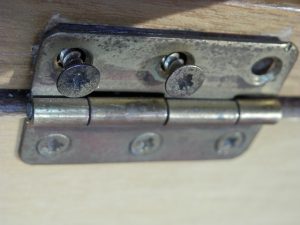
Hinges are mechanical bearings used to create a limited and fixed range of rotational movement between two workpieces. Most doors, for instance, are affixed to a frame with two or more hinges. Hinges allow doors to swing open — but typically only to a certain degree. Hinges will stop rotating upon reaching this limitation. To achieve this functionality, hinges are designed with a few basic parts.
Leaf
A leaf is a moving plate on a hinge that rotates with the workpiece to which it’s connected. With the exception of flag hinges, most hinges contain two leafs. These rectangular-shaped plates join a workpiece with another workpiece or surface. Leafs typically have holes to support screws or fasteners. To install a hinge, fasteners are driven into these holes and the underlying workpiece of surface.
Knuckle
Also known as a loop or node, a knuckle is a hollow tube that runs down the middle of a hinge. The knuckle isn’t actually a separate part. Rather, it’s created when a hinge’s leafs are joined together. The leafs have protruding ridges that interlock together when joined, thereby creating a knuckle.
In the photo above, you’ll see the knuckle between the hinge’s two leafs. Each leaf has protrusions that interlock with those of the opposite leaf. When the two leafs are joined together, a knuckle is created. The knuckle essentially creates a hinge’s joint.
Pin
Also known as a pintle, a pin is a narrow cylindrical-shaped plug that’s placed through the hollow center of a hingle’s knuckle. The protrusions on a hinge’s leaf are hollow. Therefore, the knuckle they create is hollow as well. A pin is a rod-like component that’s inserted through the center of the knuckle to hold the leafs together.
A hinge’s leafs can only interlock together when a pin is inserted through the knuckle. Without a pin, the leafs won’t stay connected. And if the leafs aren’t connected, the hinge won’t create a joint. A pin offers a simple solution by preventing the separation of the leafs.
In Conclusion
Most hinges consist of three basic parts: leafs, a knuckle and a pin. Leafs are the rectangular-shaped plates on the sides of a hinge. A knuckle is a cyldrical-shaped tube that’s created when the leafs are joined together. A pin is a solid metal rod that’s inserted through the knuckle to interlock the leafs. All three of these parts allow hinges to create a joint.
